Gig Review: Louisa Williamson @ Wellington Jazz Festival @ San Fran, Wellington - 17/10/2024
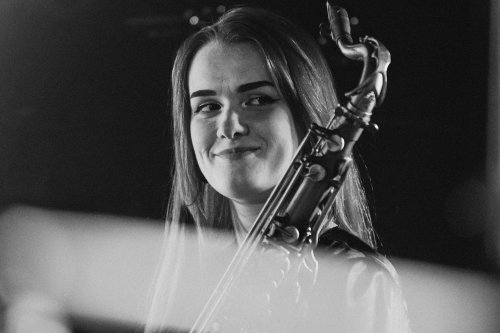
Louisa Williamson
This gig was part of the Wellington Jazz Festival 2024 (October 16- 20).
On Thursday night we climbed the stairs, bought our wines and settled in to experience the debut of an specially commissioned piece called The Chasm Where We Fall Into Each Other, written by saxophonist, composer, and band leader Louisa Williamson, as part of this year’s Wellington Jazz Festival. It was a fine thing to see the awaiting queue snake up Cuba Street, a solid confirmation that Wellingtonians love their Jazz and an opportunity to get out and experience new music in all its forms. It was close to a full house, seated and civilised, many of our more genteel members of society chose to ‘slum’ with the kids at Poneke’s own version of CBGB’s. I heard a few audible gasps when a couple of more well-heeled and senior patrons emerged from the highly ‘decorated’ conveniences, not appreciating the value of graffiti and tagging was all part of the venue’s legendary charm.
Backed by a young and truly gifted eight-piece, Williamson led her band through a series of pieces that make up the full body of the Chasm work. There featured many moments for a violinist (Hayden Nickel), keyboards (Leo Coghini) and drums (Cory Champion), bass (Johnny Lawrence) and plenty of colour from a multi-tasking percussionist (Ensai).
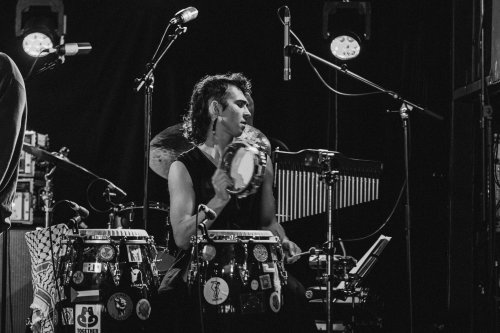
Ensai (Percussion)
The work, she told me in a recent interview, “explores the concept of division both literally and figuratively. It’s easy to fall into the chasm you didn’t know was there.” The chasm was partially inspired by the ancient Putuna Chasm, in the Wairarapa and serves both a both physical and mental reference point. It also spans, for her, between the past and the present. The chasm is a centuries-old faultline with an underground river that flows through it to the surface. The present, as appears in some of her lyrics, more mundane and physical things like pavement cacks and broken hearts. There are rifts, politically, ideologically, and artistically, as well.
Tonight’s music was blend of avant-garde jazz, classical, electronic, rap, and hip-hop. At times, it was the traditional Charlie Parker and Mingus arrangements, similar to Rodger Fox’s choices (of which, no surprise, Williamson cut her chops playing with in the Rodger Fox Big Band).But there are also elements of soul and rap, Te Reo Maori gets a few seconds in the spotlight, as does a few nods to choral work and even salsa.
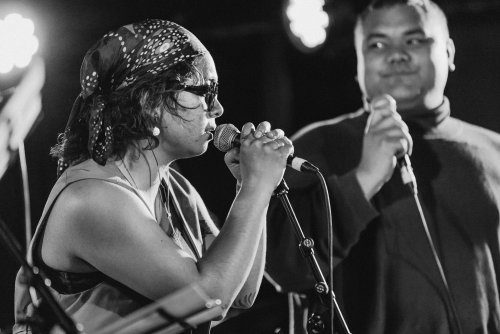
MA
The piece starts with a rolling effect, all instruments in a syncopated tide, before flowering out into a flowering out into a braided river of soulful inflections, punctuated by some wonderful performances by Ma (Maarire Brunning-Kouka) and Aotearoa/Samoan Opera singer Lila (LJ) Crichton. LJ’s vocals are so honey-sweet they may the hairs on the back of the neck stand up. Watch this space, this talent will go far, I believe. As the piece moves along, a spicy salsa beat emerges giving a perfect platform for Williamson’s smooth and throaty alto sax solo, the first of several brilliant moments in this performance.
Ma shines on the second half of the piece with streetwise nu-soul vocals that reminded me of Erykah Badu. Her approach is tough, but sassy, and her command of the mic is all class.
The second piece moves slowly at first (like the river in the chasm) on a trickling, repeating riff of just bass, keys and single notes from an electric violin. As it builds, Williamson’s sax comes in like a dark overcoat of sound. LJ’s operatic tenor vocals sweeten the mood, then joined by Ma for the ‘chorus lines’ “Take all of me/We’ll find a bridge to set you free.” This is a line that will repeat and repeat.

LJ Crichton
Then it all builds again toa torrent of sound, like a heavy stream, with a rockier pop beat and a groovy sax solo. There are breaks for percussion and keys, aptly played before it all slows down, like a train or, to carry on the water analogy, like a ship docking, slowly and with a heavy weight of responsibility.
The next piece has a slower classical feel, reminding me of some of repertoire from Fox’s tuition classes, his legacy is all over this (and I say that in a supportive way – being the hero of Jazz for so many of our most talented musicians).
For a short time Ensai plays a taonga puoro, a flute, a koauau, I believe. I wish that there was more space of this in the composition. But it’s a brief appearance, sadly. Because there must be room made for sparring between Williamson’s sax and Ensai’s other percussive instruments (especially bongos and some tiny tinkling bel chimes, which have a fairy-like presence).
More solos, from Williamson, and drummer Cory Champion, who adopts a slow tension build up, relying heavily on his floor tom for an almost tribal beat. That gives way eventually to a sexy lounge solo from keyboardist Leo Coghini. Towards the end of his feature, he breaks into a synth part that sounds like a heavy metal guitar solo. I squinted to see if someone else had snuck in on stage – but no. That was a cool an unexpected addition.

Cory Champion
The groove continues, giving Ma the opportunity to bust out a few rhymes. It would have been good to be able to hear these just a bit more clearly – sadly, they got lost in the mix.
It all sweels like the waters of Putuna to a raging torrent, exploding into the daylight from the dark depths. And finally, and reluctantly, the natural machine of the Chasm slows down, as the opening roll in reverse until, inevitable, silence.
The reception was warm, with many on their feet in appreciation. Overall, I think a triumph. I was just a little bit proud myself that such talent came from my own hometown – as were the audience, many friends and whanau and quite rightly fulling owning their own joy and appreciation. We were promised and twist in the conventions of jazz as we know it, and I think we got it. Well done, Louisa Williamson. This was just brilliant! Mauruuru koe. Kia rere noa nga wai o to taranata ki te moana angitu!
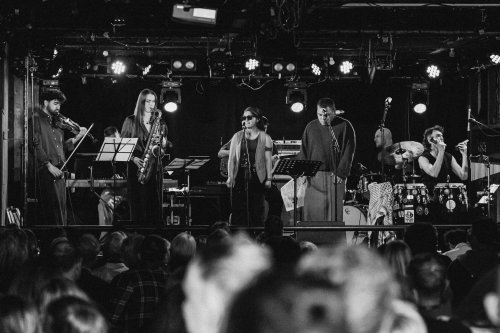
Photo Credit: Nick George
Other Reviews By Tim Gruar
 Gig Review: The Phoenix Foundation @ Meow Nui, Wellington - 14/12/2024
Gig Review: The Phoenix Foundation @ Meow Nui, Wellington - 14/12/2024
15 Dec 2024 // by Tim Gruar
Te Whanganui a Tara’s favourite sons, The Phoenix Foundation broke the mould many times over to create their own unique templates that elevate the average pop song into something really special. For decades they’ve been making beautiful, lush, twee-pop with layers of inventive cleverness.
Read More...
 Gig Review: Wiri Donna @ San Fran, Wellington - 6/12/2024
Gig Review: Wiri Donna @ San Fran, Wellington - 6/12/2024
08 Dec 2024 // by Tim Gruar
I’ve been following Bianca Bailey’s (AKA Wiri Donna) career for some time now and her music has gone from strength to strength. Bold, melodic, indie pop with a distinctive flavour and a unique, recognisable sound, she’s managed to carve out her own niche on student and independent radio with a brilliant EP (Being Alone 2022) and a raft of great singles.
Read More...
 Rachel Louise - EP Review: Wasted/Our Time
Rachel Louise - EP Review: Wasted/Our Time
05 Dec 2024 // by Tim Gruar
You’ve got to admire Tamaki Makaurau independent pop artist Rachel Louise (aka Rachel Mawdsley). Not only does she write and perform her own material but she’s on the publicity machine cranking out releases and flying the flag for her unique and beautiful music, too.
Read More...
 Oakley Grenell - Album Review: Echoes
Oakley Grenell - Album Review: Echoes
04 Dec 2024 // by Tim Gruar
Offspring of one of Aotearoa’s most famous songs, John Hore Grenell, and brother of Country/Folk artist Amiria Grenell, Oakley cut his teeth down in Otautahi over a decade ago under the tutelage of Jazz greats like Mike Nock. I first got to meet him back in 2008 as he was preparing to fly the ditch following the release of his lounge/funk mix-up called Moving On.
Read More...
 Rita Mae - EP Review: Kiss The Sky
Rita Mae - EP Review: Kiss The Sky
13 Nov 2024 // by Tim Gruar
They say that your whakapapa defines you. That can be a good thing or a weighty stone around your creative neck.
Read More...
 Sally Stockwell - Album Review: Little Triggers
Sally Stockwell - Album Review: Little Triggers
12 Nov 2024 // by Tim Gruar
In the new video Far & Wide (one of three planned for release) Otautahi-based artist Sally Stockwell bursts through the front door, rushes down the driveway and doesn’t stop running until she reaches the sea. The camera pans back to her two cherub angels deliberately spilling milk on the kitchen floor and jumping about on the best couches.
Read More...
 The Nomad - Album Review: Infinite III
The Nomad - Album Review: Infinite III
08 Nov 2024 // by Tim Gruar
There was a time when Daimon Schwalger, AKA The Nomad, was on every airwave, headlining every essential EDM event. His sets at seminal gigs like The Gathering were legendary.
Read More...
 Gig Review: Drax Project @ Hunter Lounge, Wellington - 2/11/2024
Gig Review: Drax Project @ Hunter Lounge, Wellington - 2/11/2024
03 Nov 2024 // by Tim Gruar
Local lads Drax Project have moved far away from their impromptu busking gigs on Courtenay Place, having just wrapped a near sell out headline tour across Blighty, Europe and Aotearoa in support of their super cool sophomore effort Upside (2023). And most recently, they’ve been stomping around the motu revving up local crowds, and a few Aussies stages, to much acclaim.
Read More...
Most Viewed Artists
Latest Galleries
NZ Top 10 Singles
- APT.
ROSÉ And Bruno Mars - DIE WITH A SMILE
Lady Gaga And Bruno Mars - BIRDS OF A FEATHER
Billie Eilish - TASTE
Sabrina Carpenter - I LOVE YOU, I'M SORRY
Gracie Abrams - ESPRESSO
Sabrina Carpenter - SAILOR SONG
Gigi Perez - LOSE CONTROL
Teddy Swims - A BAR SONG (TIPSY)
Shaboozey - GOOD LUCK, BABE!
Chappell Roan




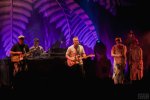
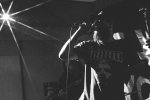


 Report A Problem
Report A Problem

